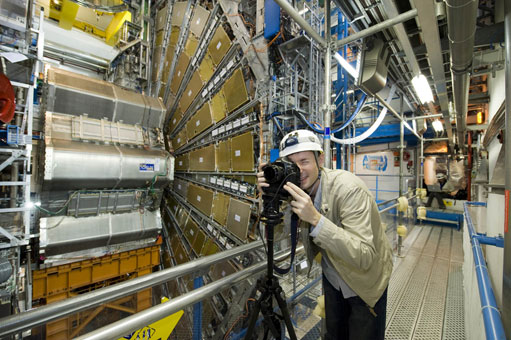
ATLAS e-News
23 February 2011
ATLAS gets the Hollywood treatment
2 June 2008

Photographer Richard Stammers near the big wheel and toroid endcap
Strangers photographing the ATLAS detector are a familiar sight for those working down in the pit. But last week, things were a little bit different: the detector was being photographed in preparation for its Hollywood debut in the dramatisation of Dan Brown’s best-seller Angels and Demons.
Anyone at ATLAS who has read the novel is sure to have their own opinions on the author’s particular “creative” take on the laws of physics and his representation of CERN. But, like it or not, CERN plays an important part in the story – as the location from which antimatter is stolen by a secret society intent on creating a bomb to destroy the Vatican.
Richard Stammers, Visual Effects Supervisor with the Moving Picture Company (MPC), based in Soho, London, spent the day in the cavern taking photographs of the detector from every conceivable angle. “We use these with our own in-house software – an image-based modelling tool – to pinpoint certain areas within each image that are also in other images,” he explains. “From that we can extrapolate a 3D model which is scale accurate, and the photographs can then be used as textures to apply to that model.”
Stammers captured images of the detector from a range of vantage points, his ultimate aim being to create a 3D view of it as it is seen from the fourth level platform. This will allow the company to later recreate any different perspective on the detector – from that level – that they wish.
“For the film, they’re intending to create a ‘lab view’ as if the scientists viewing the detector are behind a window looking onto it,” Stammers explains. “So [the film company] will create a set in Los Angeles which has a view out onto a blue screen. Where that screen is visible, we will replace the view – through all of our digital trickery – with a reconstructed image of the detector, based on the photographs I’ve taken.”
The implication that physicists could operate the detector in close proximity, shielded only by a sheet of glass, is bound to ruffle the feathers of anyone who knows the first thing about the health risks involved with radiation and magnetic fields, and the stringent safety measures employed by ATLAS. But aside from this blatant bending of the truth in the pursuit of a dramatic scene, director Ron Howard is apparently keen to make the physics in the film more plausible than it was in the original book. He visited CERN in July 2007, and spoke with CERN antimatter expert, Rolf Landua, as he took a tour of Point 1.
MPC is a digital post-production company charged with creating some of the visual effects for the film. Following an initial shoot by the central Angels and Demons visual effects department just over a month ago, Stammers came to CERN to capture as much additional footage as possible before the cavern becomes inaccessible later this summer.
As well as taking photographs, he was also recording video footage which will help verify the image that the company creates from the stills. “We’ll use an additional bit of software to track the motion of the footage, to give us a 3D point cloud which can tell the difference between something that is near and something that is far away,” he explains.
One of a lucky few, Stammers was even able to get right inside the calorimeter region just before it was closed as part of the preparations for the first beam. Back on the platform, he was quite taken aback by the sheer scale of the detector. “It’s huge!” he exclaimed. “I’d seen quite a lot of pictures before, but when you actually stand in front of it… It’s an amazing piece of engineering to be able to create something so vast underground that’s going to do something so interesting.”
Shooting for the film, which will take place in Rome, Boston USA and Los Angeles USA, will run from June until October, with the film likely to be released in summer 2009.

Ceri PerkinsATLAS e-News
|